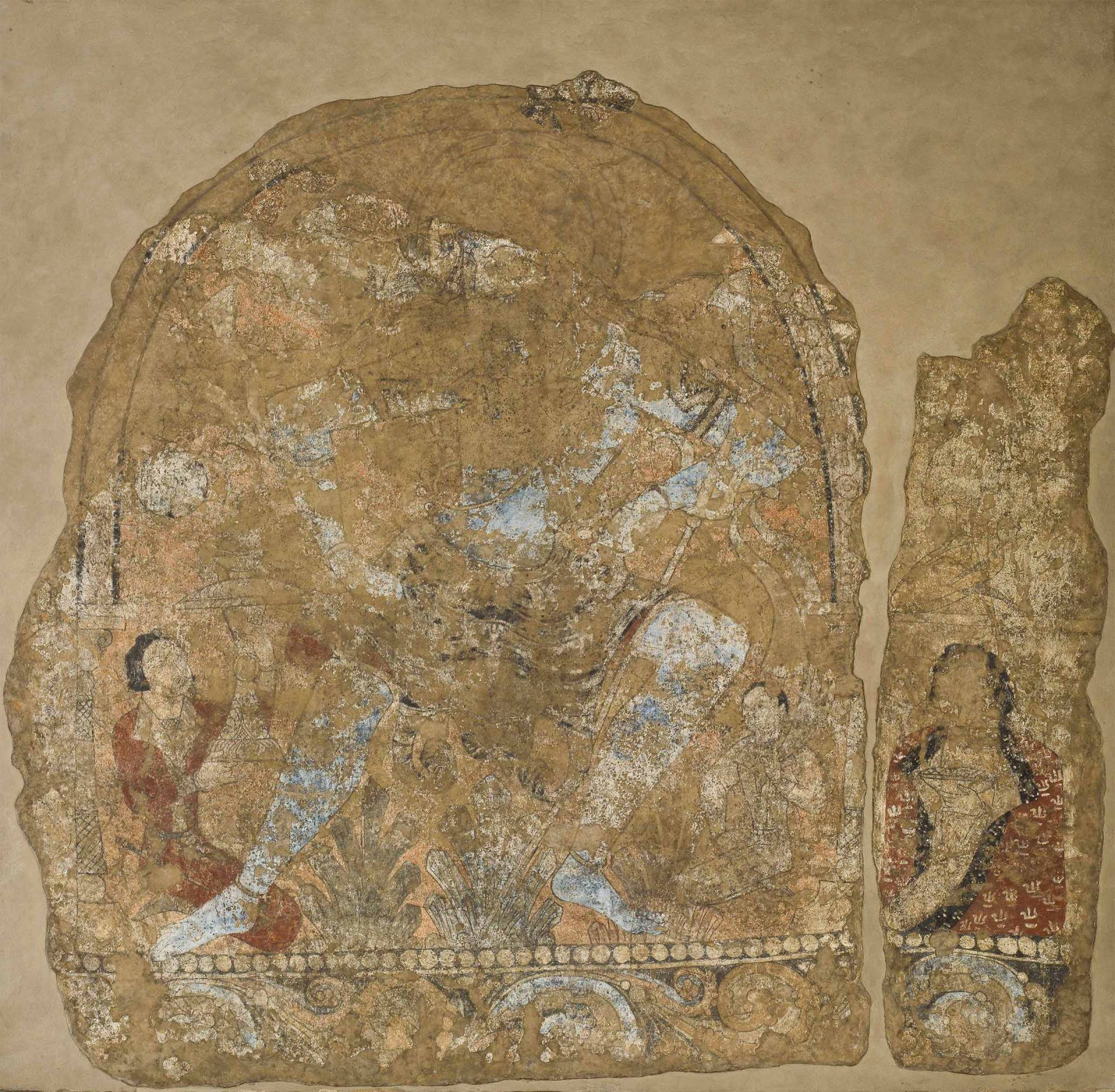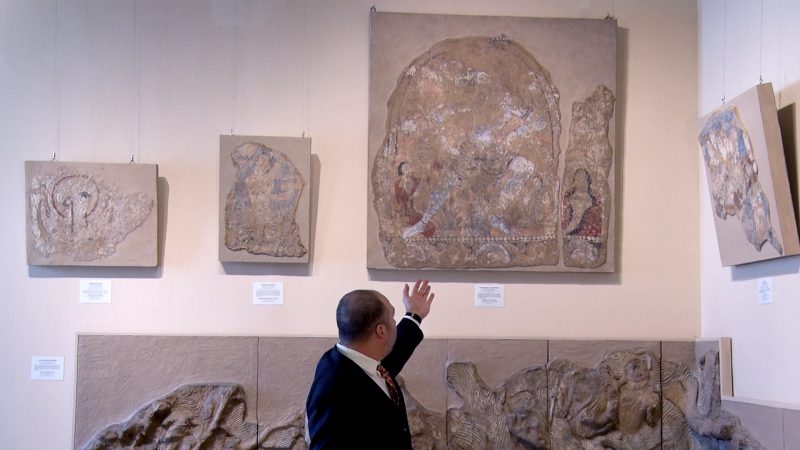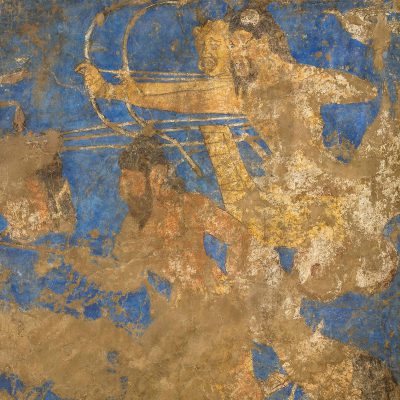
Shiva with Trisula
Shiva with Trisula
Sogdian, 7th–8th century CE
Room in a Panjikent house, VII/24, Panjikent
Painted wood panel; H. 154 × W. 147 cm
The State Hermitage Museum, St. Petersburg, Acc. No. V (B-2704)
Photograph © The State Hermitage Museum.
Although largely faded, the once–bright blue colors used to depict the body of the Hindu deity Shiva still dominate this image. Framed by a decorated arch supported by two half-columns, this complex representation of Shiva depicts the deity with a halo, poised in what some scholars believe is either a dancing or an alidhasana stance, with one leg bent at the knee and the other stretched forcefully to the side. The position is different from the traditional pose of Shiva in Indian iconography, or symbolic imagery, and we must therefore try to understand it within the Central Asian conception of Shiva at Panjikent. Between his legs are acanthus leaves. Shiva is bare-chested, his only attire a tiger skin around his waist. He wears elaborate armlets and bangles on his ankles and wrists. His left arm rests on a trisula, or trident, while his right arm seems to rest on his thigh. In the field, to the right, is a circular motif, which may be an astral motif or a lotus symbol.
This image of Shiva was painted on a mud-brick wall found in a decorated room, VII/24, of a private house. The depiction clearly reflects the cosmopolitan environment of Panjikent,The City of Panjikent and Sogdian Town-Planning Learn more about Panjikent and Sogdian town-planning conflating Greek, Iranian, and Indian symbolic elements. Although the trident is a well-known attribute of the Greek water deity Poseidon, here, as Shiva’s attribute, it signifies the Hindu god’s ability to destroy evil and bestow grace, thereby severing the human soul from the endless cycle of reincarnation. Shiva’s blue skin and the thread with amulets placed around his chest are typical elements found in Indian iconography for this deity.
The painting includes two worshipers dressed in Sogdian attire, located to the right and left of Shiva’s feet. The male figure wears a red caftan and raises a carved and highly decorated incense burner. Although it is difficult to recognize the object that the female holds, it can most likely be identified as a sheaf of vegetation. The presence of an incense burner might suggest a connection to a Mazdean practice, but incense burners are used in Hindu rites as well. Outside the arched vault are two registers, with a kneeling figure in each. The one in the upper register wears a sword at his waist, while the second individual, in the lower register, holds an open bowl and is draped in a red mantle decorated with trident motifs.
Such eclectic images reached Panjikent along the busy routes connecting Sogdiana to other parts of Asia, including India, perhaps carried by merchants or travelers who actually worshipped Shiva. At Panjikent these images were absorbed and adopted by at least some of the native residents. Shiva also appears in a large clay statue at Panjikent’s Temple II, seated on his bull, Nandi, with his wife, Parvati, set upon his thigh.
by Antonietta Cantanzariti

Fig. 1 Pavel Lurje (The State Hermitage Museum) describes the painting of Shiva, on display at the State Hermitage Museum in St. Petersburg.
According to at least one author, Shiva stands in the vigorous alidha attitude of a bowman discharging his arrow. See P. Banerjee, “A Śiva Icon from Piandjikent,” Artibus Asia 31, no. 1 (1969): 73–80.
Aleksandr M. Belenitski [Belenitsky/Belenizki] and Boris I. Marshak [Marschak/Maršak], “L’art de Piandjikent à la lumière des dernières fouilles (1958–1968),” Arts Asiatiques 23, no. 1 (1971): 3–39.
P. Banerjee, “A Śiva Icon from Piandjikent,” Artibus Asia 31, no. 1 (1969): 73–80.
Frantz Grenet, “The Second of Three Encounters between Zoroastrianism and Hinduism: Plastic Influences in Bactria and Sogdiana (2nd–8th c. A.D.),” Journal of the Asiatic Society of Bombay 69, James Darmesteter Commemoration Volume (1994): 41–57.
Banerjee identifies the item held by the female figure as a chauri (a ceremonial fly whisk).
Ciro Lo Muzio, “The Umāmaheśvara in Central Asian Art,” Rivista degli Studi Orientali 86, nos. 1–4 (2002–3): 49–86.


